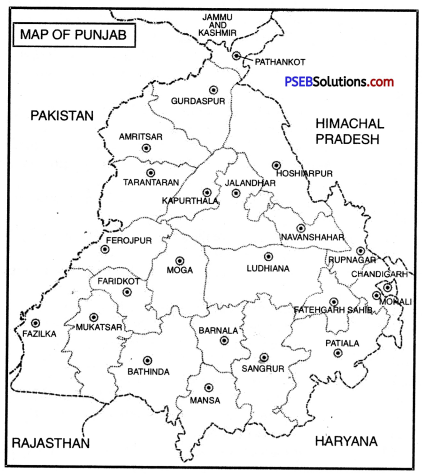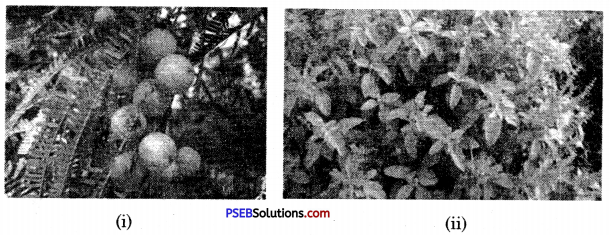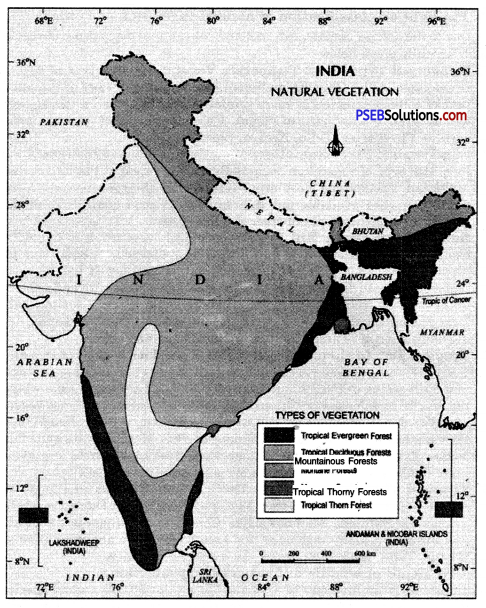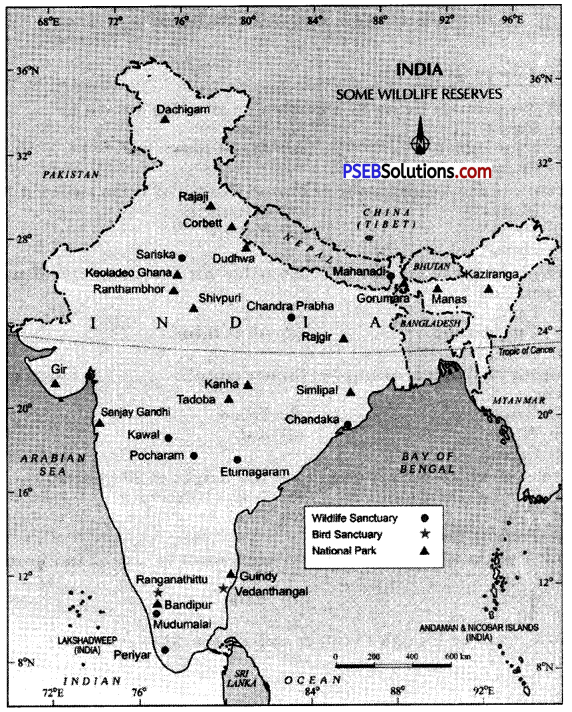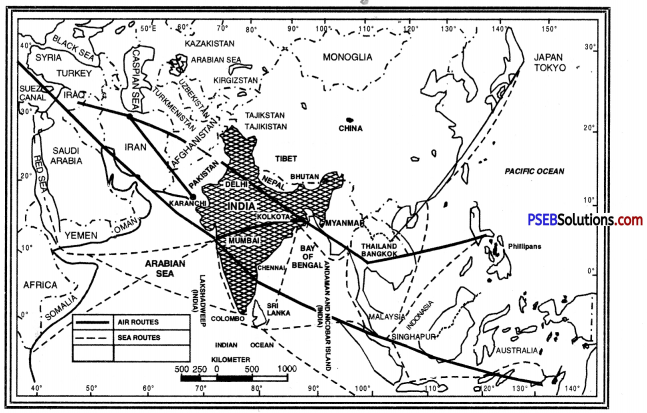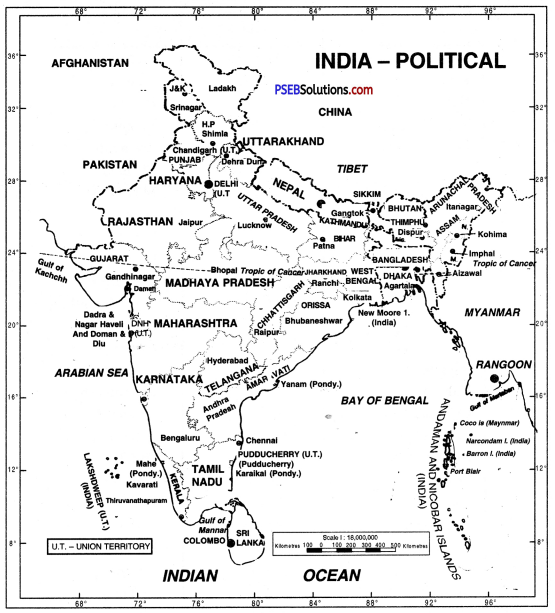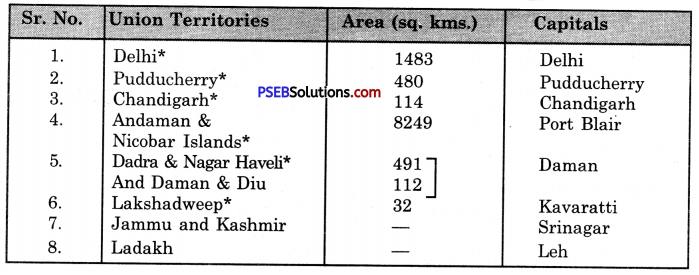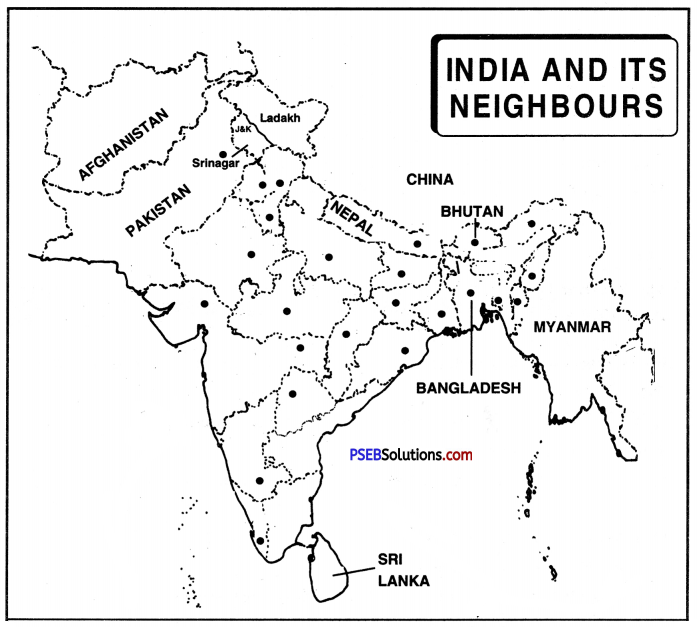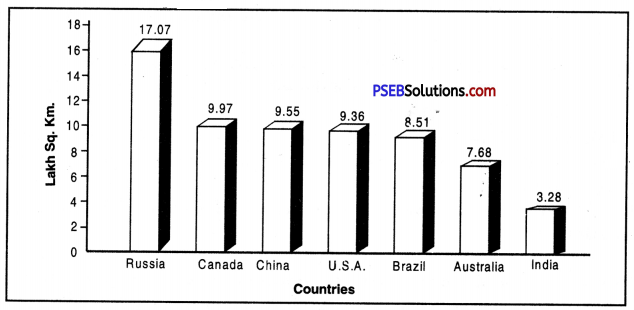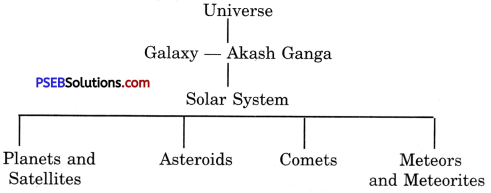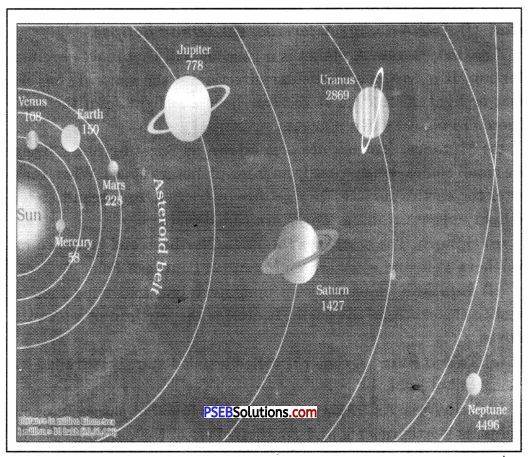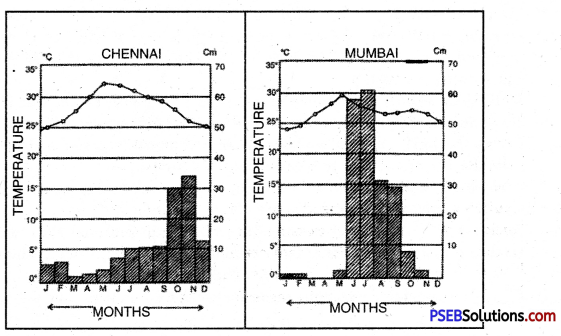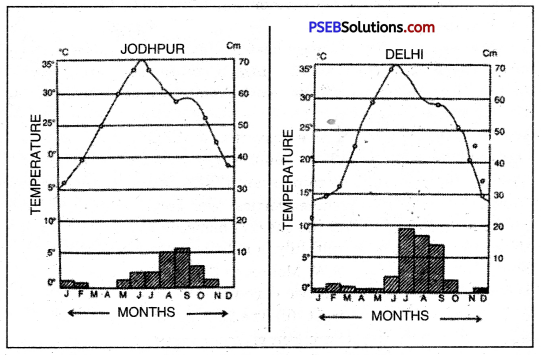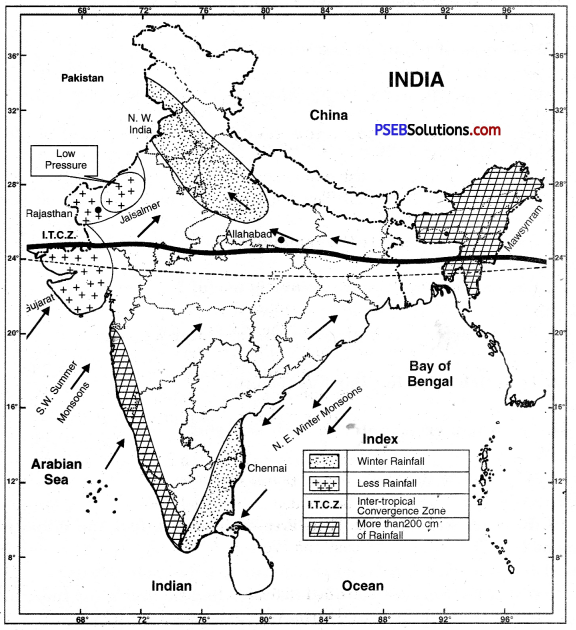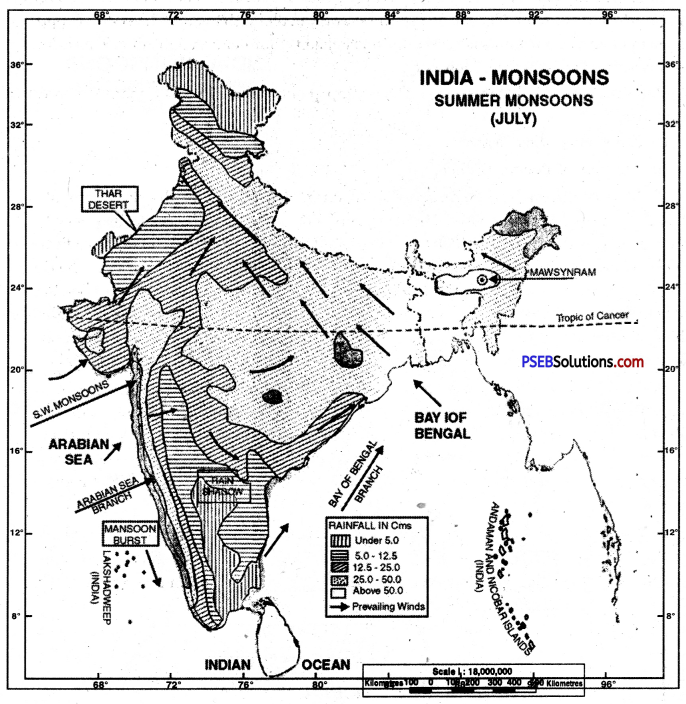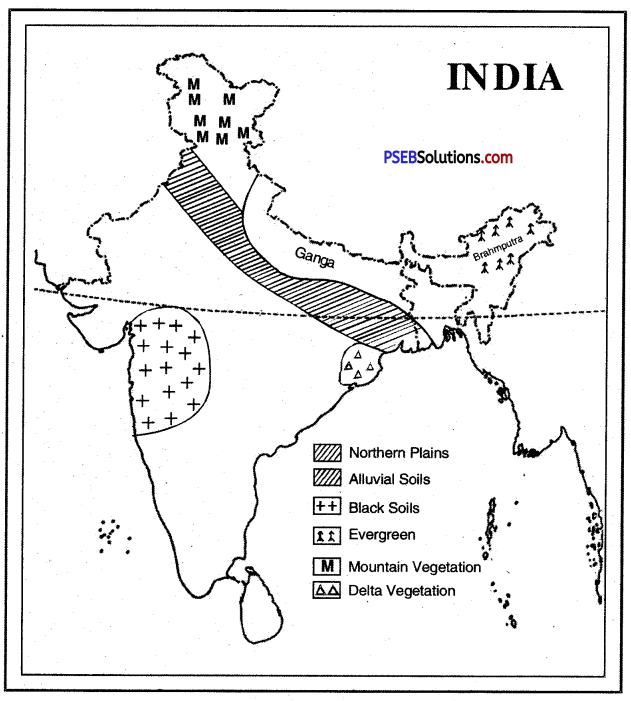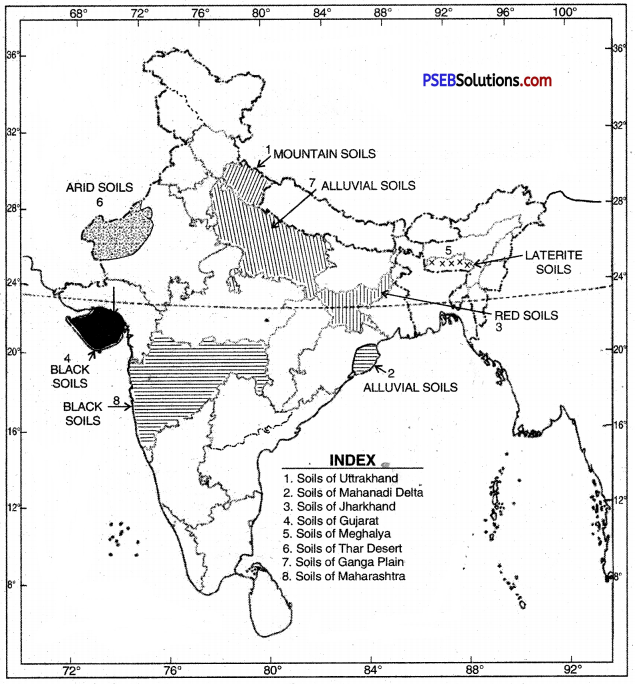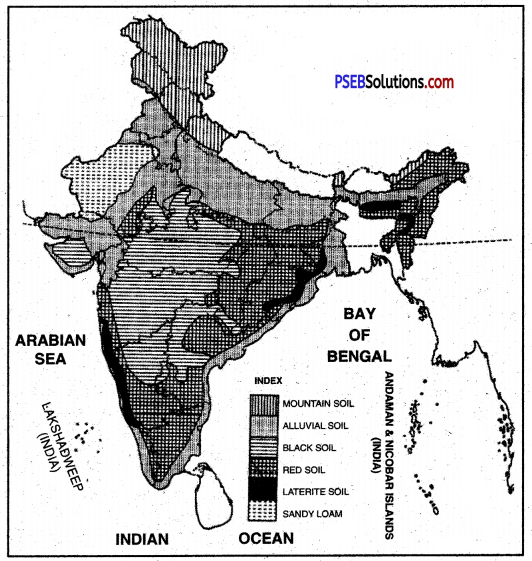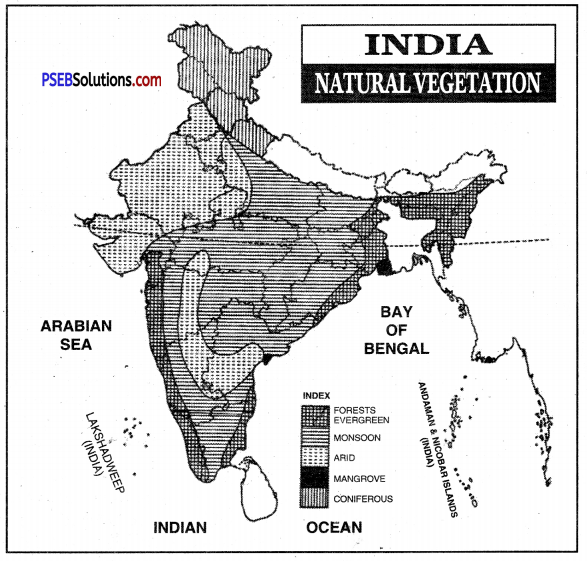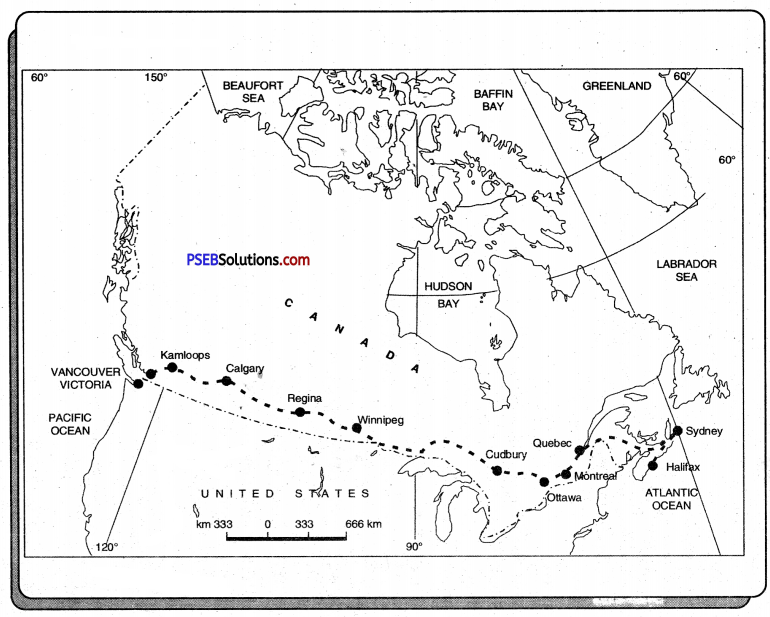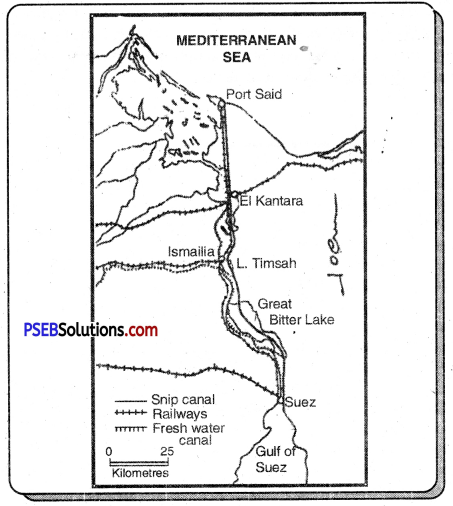Punjab State Board PSEB 9th Class Social Science Book Solutions History Chapter 3 Development of Sikh Religion (1539-1581) Textbook Exercise Questions and Answers.
PSEB Solutions for Class 9 Social Science History Chapter 3 Development of Sikh Religion (1539-1581)
SST Guide for Class 9 PSEB Development of Sikh Religion (1539-1581) Textbook Questions and Answers
I. Multiple Choice Questions :
Question 1.
Which Guru Ji started the construction work of the Baoli at Goindwal
(a) Guru Angad Dev Ji
(b) Guru Amar Das Ji.
(c) Guru Ram Das Ji
(d) Guru Nanak Dev Ji.
Answer:
(a) Guru Angad Dev Ji.
Question 2.
What was the total number of Manjidars?
(a) 20
(b) 21
(c) 22
(d) 23.
Answer:
(c) 22.
Question 3.
To which Guru Sahib did Mughal flmperor Akbar come to meet at Goindwal Sahib?
(a) Guru Nanak Dev Ji
(b) Guru Angad Dev Ji
(c) Guru Amar Das Ji
(d) Guru Ram Das Ji.
Answer:
(c) Guru Amar Das Ji.
Question 4.
Where did Bhai Lehna Ji go to see Guru Nanak Dev Ji?
(a) Shri Amritsar Sahib
(b) Kartarpur
(c) Goindwal
(d) Lahore.
Answer:
(b) Kartarpur.

Question 5.
To which of his sons did Guru Ram Das Ji entrust the Gurugaddi?
(a) Prithichand
(6) Mahadev
(c) Arjundev
(d) None of these.
Answer:
(c) Arjundev.
II. Fill in the blanks :
Question 1.
Shri Guru Angad Dev Ji wrote __________ in Gurmukhi script.
Answer:
Bal Bodh
Question 2.
__________ used to visit Haridwar for taking dip in the holy Ganga.
Answer:
Guru Amar Das Ji
Question 3.
__________ constructed Baoli at Goindwal Sahib.
Answer:
Guru Amar Das Ji
Question 4.
Shri Guru Ram Das Ji established __________city.
Answer:
Ramdaspur (Amritsar)

Question 5.
The Bani ‘Laavan’ is the famous composition of Guru __________
Answer:
Guru Ram Das Ji.
III. Match the following :
Question 1.
|
A
|
B
|
| 1. Baba Buddha Ji |
(i) Amrit Sarovar |
| 2. Masand System |
(ii) Shri Guru Ram Das Ji |
| 3. Bhai Lehna Ji |
(iii) Shri Guru Angad Dev Ji |
| 4. Manji System |
(iv) Shri Guru Amar Das Ji |
Answer:
|
A
|
B
|
| 1. Baba Buddha Ji |
(iv) Shri Guru Amar Das Ji |
| 2. Masand System |
(ii) Shri Guru Ram Das Ji |
| 3. Bhai Lehna Ji |
(iii) Shri Guru Angad Dev Ji |
| 4. Manji System |
(i) Amrit Sarovar |
Differentiate between the following :
Question 1.
Sangat and Pangat
Answer:
Sangat: Sangat is the group of the followers of the Guru who sit together to follow the preachings of the Guru.
Pangat: According to Pangat, all the followers of the Guru used to eat collectively the food made in the common kitchen.
IV. Very Short Answer Type Questions
Question 1.
What was the earlier name of Guru Angad Dev Ji?
Answer:
Bhai Lehna was the earlier name of Guru Angad Dev Ji.
Question 2.
What do you mean by Gurmukhi?
Answer:
The meaning of Gurmukhi is the words uttered by the Guru. Presently all the religious books of the Sikhs are in this language.
Question 3.
Who was known as a Manjidar?
Answer:
The head of the Manji was known as a Manjidar. They acted as a bridge between Guru Ji and the Sikh Sangat.

Question 4.
What was the old name of Amritsar?
Answer:
The old name of Amritsar was Ramdaspura.
Question 5.
What was the real name of Guru Ram Das Ji?
Answer:
Bhai Jetha Ji was the real name of Guru Ram Das Ji.
Question 6.
What do you understand by Masand System?
Answer:
Guru Ramdass Ji needed a large amount of money to complete the construction work of ponds (Sarovars) of Amritsar and Santokhsar. Therefore, Guru Sahib started Masand System. Guru Sahib deputed his trusted Sikh devotees to go to far off places to spread the message of Sikh religion and collect donations. Such devotees were called Masands. These Masands successfully spread the message of Sikhism and collected large donations. This system played a major role in the spread of Sikh religion to far off places. The Masand system proved to be a link between the Sikh devotees and Guru Sahib and established an emotional bond between them.
V. Short Answer Type Questions
Question 1.
Write a note on Manji System.
Answer:
The Manji System was founded by Guru Amar Das Ji. The number of the Sikh followers had increased immensely by the time of Guru Amar Das Ji. However, Guru Amar Das Ji was very old and it was difficult for him to visit his large spiritual empire of Sikh followers in order to spread his teachings. Hence, Guru Sahib divided his spiritual empire into 22 regions called the Manjis. Each Manji was further divided into Pidees. The Manji System had great significance in the history of Sikh religion.
Question 2.
What was the contribution of Guru Angad Dev Ji in the development of Gurmukhi Script?
Answer:
Guru Angad Dev Ji made improvements in the Gurumukhi Script. In order to popularise Gurmukhi, Guru Sahib wrote Bal Bodh to help the children learn the alphabet of Gurmukhi. The Gurmukhi was a common language of the people of the region. It helped in the promotion of Sikh religion. All the religious literature of Sikhism is written in Gurmukhi script.

Question 3.
Write a short note on the social reforms of Guru Amar Das Ji.
Answer:
Guru Ji did the following social reforms :
- Guru Amar Das Ji criticised the caste system. Guru Ji believed that caste based differences were against the wishes of the Supreme God. That’s why the langar system of Guru Ji does not keep any discrimination of caste system.
- Another social evil of Sati system prevailed during those days. Guru Ji strongly opposed the evil of Sati System.
- Guru Ji strongly criticised the Purdah system prevalent among the women. Guru Sahib considered purdah as the main hindrance in the development of society.
- Guru Ji was against the use of intoxicants. That is why Guru Ji instructed the Sikhs to remain away from the intoxicants.
Question 4.
Write a note on the founding of Amritsar.
Answer:
Guru Ram Das Ji founded Ramdaspura. This city is now called Amritsar. Guru Ram Das Ji had started the work of digging of two sarovars (ponds) called Amritsar and Santokhsar in 1577 A.D. Guru Sahib found that it was difficult to look after the work of construction of the ponds from Goindwal. Hence, Guru Sahib decided to camp at the site of construction at Amritsar. His followers started visiting him at his camping sight and some of them also stayed there, which led to the rise of a small township. This township was lovingly named Ramdaspur, Guru Ram Das Ji tried to provide all the amenities to his followers who were staying there because of their devotion to him. Guru Sahib also established a small market there. That market became popular as ‘Market of Guru Ji’ or ‘Guru ka Bazaar’. In this manner, the city became an important place of pilgrimage and trading centre for the Sikhs and contributed in a significant way to the growth of Sikh religion.
VI. Long Answer Type Questions
Question 1.
Shri Guru Angad Dev Ji contributed significantly towards the development of Sikhism. Discuss.
Answer:
Guru Angad Dev Ji became the second Guru of the Sikh religion in 1539 after Guru Nanak Dev Ji. His period proved to be a blessing for the Sikh religion.
Guru Sahib contributed to the development of the Sikh religion in the following manner :
1. Improvement in Gurmukhi Script. Guru Angad Dev Ji made improvement, in Gurmukhi script in order to popularise Gurmukhi. Guru Sahib wanted to help the children learn the alphabet of Gurmukhi. The Gurmukhi was a common language of the people of the region. It helped in the promotion of Sikh religion. All the religious literature of Sikhism is written in Gurmukhi script.
2. The Janam Sakhi of Guru Nanak Dev Ji. Guru Angad Dev Ji instructed Bhai Bala Ji to write the Janam Sakhi of Guru Nanak Dev Ji. Guru Sahib also collected all the sayings of Guru Nanak Dev Ji. It helped the Sikhs to follow the true path shown by Guru Nanak Dev Ji. Guru Sahib himself also wrote Vani in line with the teachings of Guru Nanak Dev Ji.
3. The Langar System. Guru Angad Dev Ji continued the Langar system with full devotion. Langar was served to all the people without any distinction based on caste system. It helped in decreasing the feelings of inequality based on caste system and helped in spreading the message of Sikh religion.
4. Separating the Udasis from the Sikhs. The elder son of Guru Nanak Dev Ji, Bhai Sri Chand had established the Udasi sect. He’had popularised asceticism (Sanyas). The idea of asceticism was against the fundamental teachings of Guru Nanak Dev Ji. Guru Angad Dev Ji made it clear to his followers that the Sikh religion is a religion of householders. There was no place for ascetics (Sanyasis) in it. Guru Sahib declared that those Sikhs, who believed in asceticism, were not true Sikhs. In this manner, by separating Udasis from the Sikh community, Guru Sahib strengthened the Sikh religion.
5. Laid the foundation of Goindwal. Guru Angad Dev Ji founded the city of Goindwal. This city became an important Sikh religious centre during the period of Guru Amar Das Ji. Even today, it is one of the most important religious centres of Sikhism.
6. Enforced Discipline. Guru Angad Dev Ji maintained strict discipline in his Sikh community. He turned out Bhai Satta and Bhai Balwand out of Sikh Sangat for breaking discipline. However, on the request of Bhai Laddha, Guru Sahib pardoned them. This episode served as a warning to the indisciplined elements in the Sikh community.
It is true that Guru Angad Dev Ji had given a distinct identity to the Sikh religion by making improvements in Gurumukhi script. The Sikh followers got their own separate script and language. The langar system freed the Sikh religion from the influence of caste system. It helped Sikh religion to establish its own separate identity different from the Hindu religion. All the credit goes to Guru Angad Dev Ji for all such developments which made Sikh religion a distinct religion.

Question 2.
What is the contribution of Shri Guru Amar Das Ji towards the development of Sikh religion?
Answer:
Guru Amar Das Ji occupies an important place in the history of Sikh religion. The seeds of the religion which Guru Nanak Dev Ji had sowed, sprouted during the period of Guru Angad Dev Ji. Guru Amar Das Ji raised a fence around the new religion and saved it from getting absorbed into Hindu religion. Guru Amar Das Ji helped the Sikh community to adopt new customs and traditions in their social life, which developed the real traits of Sikh religion. They were different from the social customs and .traditions of the Hindu religion. No doubt, Guru Sahib was a great divine soul. Payne, a scholar, called him an aggressive reformer. Another scholar has praised Guru Sahib as a genius and a man of justice. It is a historical fact that it was during his period that Sikh religion established its distinctive identity.
A brief survey of the work of Guru Amar Das Ji is as follows :
1. Construction of Baoli at Goindwal. Guru Amar Das Ji completed the construction work of Baoli at Goindwal which was started during the period of Guru Angad Dev Ji. Guru Amar Das Ji constructed 84 steps in the Baoli. Guru Sahib said that a Sikh could get freedom from the cycle of births and deaths covering 84 lakh forms of lives by reciting the hymns of Jupji Sahib on each step. The Baoli of Goindwal became an important place of pilgrimage for the Sikhs.
2. Langar System. Guru Amar Das Ji also made the Langar system popular which helped further in the spread of Sikhism. Guru Sahib made some more rules for Langar System. As per the new rules, whosoever wanted to earn the benefit of participation in Sangat, he must partake Langar with the rest of the Sangat before joining it in the presence of Guru Sahib. While partaking food in the Langar, Brahmins, Kshatriyas, Vaishs, Shudras, Kings, common men and people of all castes and tribes sat in one row and partook food.
Langar system propagated the message of Sikh religion in a more forceful and effective manner. It ended the discrimination based on castes. It developed the feelings of unity and equality in the Sikh Sangat. As a consequence, it bound the Sikhs into a strong bond of unity.
3. Collection of the Sayings of Guru Sahiban. Guru Angad Dev collected the true Vani’ of Guru Nanak Dev Ji and added his own Vani’ also. Guru Angad Dev Ji entrusted the sacred collection to Guru Amar Das Ji. Guru Amar Das Ji also composed his ‘Vani’ and added to the collection. In this manner, the true ‘Vani’ was preserved in a pure form and later found place in the ‘Adi Granth Sahib’. The grandson of Guru Amar Das Ji, Guru Arjan Dev Ji accomplished the ultimate task.
4. Manji System. The number of followers of Sikhism had increased manifold by the time of Guru Amar Das Ji. Guru Amar Das Ji found it difficult to reach all his disciples who were spread over a large area. Guru Sahib divided his spiritual territory into 22 regions. Each region was called a ‘Manji’. Each Manji was a centre of religious preaching and Guru Sahib appointed learned and reliable Sikh devotees to control each Manji.
The establishment of Manji system was an important step in the systematic organisation of the Sikh religion. G.C. Narang in his book ‘Transformation of Sikhism’, remarks that the introduction of Manji System by Guru Sahib, had strengthened the Sikh religion and contributed to the spread of Guru’s divine message in different regions of the country in a more effective way.
5. Separation of Sikhs from the Udasis. The Udasi sect of Bhai Sri Chand had also become popular in the early period of Guru Amar Das Ji’s Guru-gaddi. There was a possibility of Sikh religion losing its identity by being merged with the Udasi sect. It is recognised by. many historians that Guru Amar Das Ji had judged the situation and strongly spoken against the main principles of asceticism of Udasi sect, which were against the principles of Sikh religion as founded by Guru Nanak Dev Ji. Guru Amar Das Ji helped the Sikh Sangat to understand clearly that they would not be able to become true Sikhs, if they adopted the principles of Udasi sect. In this manner, because of the efforts of Guru Amar Das Ji, the Sikh religion maintained its separate identity and flourished.
6. Separate Sikh Ceremonies. Guru Amar Das Ji instructed the Sikhs to discontinue useless customs and traditions. Among the Hindus, it was a tradition of weeping and crying over the death of one’s near ones. Guru Sahib advised his disciples to meditate on God in such situations in one’s life instead , of performing useless ceremonies and rites. Guru Sahib also started a new ceremony for marriage, which was called Anand Karaj.
7. Composition of Anand Sahib. Guru Sahib composed a new Vani which is called ‘Anand Sahib’. Anand Sahib ended the importance of Vedic hymns for the Sikhs and gave them their own sacred literature.
Thus, the period of Guru Amar Das Ji’s Guru-gaddi and his sacred literature occupy the most important place in the history of Sikh religion. Guru Sahib constructed a Baoli, introduced Manji System, elaborated the Langar System, and introduced new traditions and customs in the Sikh religion which was well-organised during his days.
Question 3.
What is the contribution of Shri Guru Ram Das Ji towards the development of Sikhism?
Answer:
The fourth Guru Sahib of Sikh religion was Guru Ram Das Ji. Guru Sahib made the contribution to the growth of Sikh religion given ahead :
1. Laid the foundation of Amritsar City. Guru Ram Das Ji laid on the land bought during the period of Guru Amar Das Ji, the foundation of a city called Ramdaspur. Presently, it is called Amritsar. In 1577, when Guru Sahib started construction work on the two ponds (Sarovars) called Amritsar and Santokhsar, he found that it was not easy to supervise the construction of ponds from Goindwal. Guru Sahib encamped at the construction site. His Sikh devotees also came after him and pitched their tents around the ponds.
The camping place developed into a small settlement. That settlement became popular as Ramdaspur. Guru Sahib wanted to provide every facility to his devotees who had followed him to the place out of love for him. Guru Sahib, therefore, invited 52 merchants belonging to 52 different trades and provided all the things required by the settlers. They set up a type of Bazaar which is now called Guru Ka Bazaar. The city soon acquired the status of an important place of pilgrimage for the Sikhs. They stopped visiting the places of Hindu pilgrimage.
2. Introduction of Masand System. Guru Ram Das Ji needed a large amount of money to complete the construction work of ponds (Sarovars) of Amritsar and Santokhsar. Therefore, Guru Sahib started Masand System. Guru Sahib deputed his trusted Sikh devotees to go to far off places to spread the message of Sikh religion and collect donations. Such devotees were called Masands. These Masands successfully spread the message of Sikhism and collected large donations. This system played a major role in the spread of Sikh religion to far off places. The Masand system proved to be a link between the Sikh devotees and Guru Sahib and established an emotional bond between them.
3. End of the Conflict with the Udasis. Guru Angad Dev Ji and Guru Amar Das Ji had separated Udasi sect from the Sikh community but Guru Ram Das Ji adopted a kind attitude towards the Udasi sect. According to a tradition, once Bhai Sri Chand, the founder of Udasi sect came to meet Guru Ram Das Ji. During his meeting, Bhai Sri Chand asked Guru Sahib that why he had kept a long beard. Guru Sahib gave an answer full of humility when he said that his beard was meant to dust the feet of great personalities like Bhai Sri Chand. Bhai Sri Chand was highly impressed by the answer of Guru Sahib and he accepted Guru Sahib as superior to him. In this manner, the conflict between the Udasi sect and the Sikh community ended. It immensely helped in the spread of Sikh religion.

Question 4.
How did Sikhism flourish with the establishment of the new cities and the new traditions by the Gurus?
Answer:
The Guru Sahiban founded many cities for the spread of the Sikh religion and prosperity of their devotees. One of the main aims of founding the new cities was to provide separate places of pilgrimage to the Sikhs which could be exclusively used by them for the fulfilment of their religious needs.
They created a spirit of unity among them. A brief survey of the cities founded during the Guru periods is as given ahead :
1. Goindwal. Guru Angad Dev Ji founded the city of Goindwal. The city started developing as a religious centre since 1546, the year of its foundation. Guru Sahib entrusted the development of the city to his follower Amar Das Ji. Guru Amar Das Ji had constructed Baoli Sahib during the period of Guru Angad Dev Ji. Gradually, Goindwal became an important religious centre for the Sikhs. Presently, it is one of the most important and sacred religious places for the Sikhs.
2. Ramdaspur. Guru Ram Das Ji laid the foundation of Ramdaspur. Presently, it is called Amritsar. In 1577, Guru Sahib started work on the two ponds (Sarovars) called Amritsar and Santokhsar. Guru Sahib found that it was not easy to supervise the work of construction of the ponds from Goindwal. So Guru Sahib camped at the construction site. His Sikh devotees also came after him and pitched their tents around the ponds. The camping place developed into a small settlement. That settlement became popular as Ramdaspur. Guru Sahib was anxious to provide every facility to his devotees who had followed him to the place out of love for him. Guru Sahib, therefore, invited 52 merchants belonging to 52 different trades, and provided all the necessary things of daily life to the settlers. A type of bazaar sprang up which is now called Guru Ka Bazaar. The city soon became an important centre of pilgrimage for the Sikhs. They stopped visiting the places of Hindu pilgrimage.
3. Tarn Taran. Guru Arjan Dev Ji laid the foundation of the city of Tarn Taran in the region surrounded by the rivers Beas and Ravi. Guru Sahib had laid its foundation in 1590. The city of Tarn Taran has great importance in the history of Sikhs. Tarn Taran is a very important centre of pilgrimage just like Amritsar. Thousands of Sikh pilgrims come to take a dip in the Sarovar (tank) at Tarn Taran regularly. The city attracted the Jats of Majha region who hecame the followers of the Sikh religion. The Jats of Majha region recorded their name in the history of the region for their valour and courage which they demonstrated in the battles from time to time.
4. Kartarpur. In 1593, Guru Arjan Dev Ji founded a city in Jalandhar Doab and named it Kartarpur, meaning a ‘City of God’. Guru Sahib also got dug a well at Kartarpur which became popular as Gangsar. The city became a major centre of preaching of Sikh religion for Jalandhar Doab region.
5. Hargobindpur and Chheratta. In order to celebrate the birth of his son Hargobind Ji, Guru Arjan Dev Ji founded a city on the banks of river Beas and called it Hargobindpur. In addition to that, Guru Sahib got dug a well near Amritsar to overcome the shortage of water in the region. Guru Sahib got manufactured six pulleys (rehat) to draw water from the well. Therefore, the city became popular as Chheratta while referring to the six pulleys. Gradually, the settlement at Chheratta grew into a city and it still reminds us of the activities of Guru Arjan Dev Ji.
6. Chak Nanaki. Guru Hargobind Ji laid the foundation of Chak Nanaki near Kiratpur. Guru Sahib had bought land for this city on June 19, 1665 for Rs. 500.
PSEB 9th Class Social Science Guide Development of Sikh Religion (1539-1581) Important Questions and Answers
Multiple Choice Questions :
Question 1.
Which Guru laid the foundation of Baoli at Goindwal?
(a) Guru Arjan Dev Ji
(b) Guru Nanak Dev Ji
(c) Guru Angad Dev Ji
(d) Guru Teg Bahadur Ji.
Answer:
(c) Guru Angad Dev Ji.
Question 2.
Guru Ram Das Ji founded the city of
(a) Amritsar
(b) Jalandhar
(c) Kiratpur Sahib
(d) Goindwall Sahib.
Answer:
(a) Amritsar.
Question 3.
Guru Angad Dev Ji became the second Guru in A.D.
(a) 1479
(b) 1539
(c) 1548
(d) 1670.
Answer:
(b) 1539.

Question 4.
Guru Angad Dev Ji left this world in A.D.
(a) 1552
(b) 1538
(c) 1546
(d) 14 1$,
Answer:
(a) 1552.
Question 5.
Guru Amar Das Ji left this world in A.D.
(a) 1564
(b) 1538
(c) 1546
(d) 1574.
Answer:
(d) 1574.
Question 6.
Which Guru Sahib made Guru-gaddi hereditary?
(a) Guru Amar Das Ji
(b) Guru Ram Das Ji
(c) Guru Gobind Singh Ji
(d) Guru Teg Bahadur Ji.
Answer:
(b) Guru Ram Das Ji.
Fill in the blanks:
Question 1.
The earlier name of Guru __________ was Bhai Lehna.
Answer:
Angad Sahib
Question 2.
__________ was the fourth Guru of Sikhs.
Answer:
Guru Ram Das Ji
Question 3.
Guru Angad Dev Ji founded the city of
Answer:
Goindwal

Question 4.
The Mughal Emperor met Guru Amar Das Ji at Goindwal.
Answer:
Akbar
Question 5.
__________ was the third Guru of Sikhs.
Answer:
Guru Amar Das Ji
Question 6.
Udasi Sect was started by __________ the elder son of Guru Nanak Dev Ji.
Answer:
Baba Srichand
Question 7.
Manji System was established by __________
Answer:
Guru Amar Das Ji.
Very Short Answer Type Questions
Question 1.
Name the Guru who was earlier known as Bhai Lehna Ji.
Answer:
Bhai Lehna Ji was the earlier name of Guru Angad Dev Ji.
Question 2.
Define Langar System.
Answer:
The Langar System or Pangat refers to that tradition by which all the people without any distinction, like caste, religion, etc. sat in one row and partook food. Guru Amar Das Ji had made a rule according to which no body would come in his presence without first partaking food in the Pangat.
Question 3.
Name the Guru who laid the foundation of Baoli at Goindwal Sahib.
Answer:
Guru Angad Dev ji laid the foundation of a large well (Baoli) in Goindwal.

Question 4.
Name the Guru whom Akhar visited.
Answer:
Akbar Met Guru Amar Das Ji at Goindwal.
Question 5.
Write two objectives of the Masand System.
Answer:
The two aims of Masand System were as follows :
1. To collect the donations for the development work relating to Sikh religion.
2. To organise the Sikhs.
Question 6.
Who was the fourth Guru of the Sikhs? Which city was founded by him?
Answer:
Guru Ram Das Ji was the fourth Guru of the Sikhs and Guru Sahib built the city of Ramdaspur (Amritsar).
Question 7.
What do you know about Langar System?
Answer:
The Langar System or Pangat was started by Guru Nanak Dev Ji. Guru Angad Dev Ji continued the system with full devotion. This system proved to be a powerful agency for popularising the Sikh religion.
Question 8.
What was preached by Guru Angad Dev Ji to the Sikhs through the Sangat System?
Answer:
Guru Angad Dev Ji gave the message of peace and brotherhood and dealt a severe blow to the caste system among the Sikhs.
Question 9.
What was the contribution of Guru Angad Dev Ji towards Langar system?
Answer:
Guru Angad Dev Ji further promoted the Langar system or Pangat, which was established by Guru Nanak Dev Ji. This system worked with the voluntary support of his Sikh followers. Bibi Khiwi, wife of Guru Angad Dev Ji, managed the Pangat System with full devotion.
Question 10.
Write about the wrestling grounds established by Guru Angad Dev Ji.
Answer:
Guru Angad Dev Ji believed that the physical fitness was essential for the intellectual development of the Sikhs. That’s why he established wrestling grounds.

Question 11.
What do you know about Goindwal Sahib?
Answer:
The city of Goindwal is situated on the bank of river Beas. Guru Amar Das Ji constructed here a baoli, a large oblong tank of water. In the course of time, Goindwal became an important centre of Sikh pilgrimage.
Question 12.
Write the views of Guru Amar Das Ji about Caste System.
Answer:
Guru Amar Das Ji was strongly against untouchability and discrimination based on Caste System (Jati System).
Question 13.
What were the views of Guru Amar Das Ji about the Sati System?
Answer:
Guru Amar Das Ji strongly criticised the practice of Sati.
Question 14.
How was Goindwal Sahib founded by Guru Amar Das Ji? How was it different from other religious places?
Answer:
Goindwal was different from the other religious places in many ways.
- The city was built with the voluntary service (Kar sewa) of the Sikhs.
- The Sikh devotees had no faith in the worship of any god or goddess or any priest in the city.
Question 15.
What reforms did Guru Amar Das Ji introduce for marriage, birth and death ceremonies?
Answer:
- Guru Amar Das Ji replaced the ceremony of Pheras (going around the fire pit in Hindu marriage) with the ceremony of Lavan in Sikh marriage.
- Guru Sahib started the ceremony of singing the ‘Anand Vani’ at the time of birth and marriage.
Question 16.
Write about the importance of Ramdaspur or Amritsar.
Answer:
The Sikhs got their own city of pilgrimage and an important business centre with the founding of Ramdaspur or Amritsar.
Question 17.
Write about the importance of the meeting between Guru Ram Das Ji and the Mughal emperor Akbar.
Answer:
Friendly relations developed between Guru Ram Das Ji and Akbar when Akbar met Guru Sahib at Goindwal.
Question 18.
Name the parents of Guru Angad Dev Ji.
Answer:
The name of father of Guru Angad Dev Ji was PheTuman and name of the mother was Sabrai Devi.
Question 19.
To whom was Bhai Lehna married?
Answer:
Bhai Lehna (Guru Angad Dev Ji) was married to Bibi Khivi.

Question 20.
Who established the Udasi Sect?
Answer:
Baba Sri Chand, the elder son of Guru Nanak Dev Ji, established the Udasi Sect.
Question 21.
Which place was the centre of religious activities of Guru Angad Dev Ji?
Answer:
Khadoor Sahib in Amritsar district.
Question 22.
Where and when was Guru Amar Das Ji born?
Answer:
Guru Amar Das Ji was born in 1479 A.D. in village Basarke in district Amritsar.
Question 23.
Describe one difficulty which Guru Amar Das Ji faced on occupying Guru-gaddi.
Answer:
He was faced with the opposition of Bhai Dattu and Bhai Dasu.
Question 24.
How many children did Guru Amar Das Ji have?
Answer:
Guru Amar Das Ji had two sons and two daughters.
Question 25.
How many steps were constructed in the Baoli (Large Well) at Goindwal?
Answer:
Guru Amar Das Ji got constructed 84 steps in the Baoli at Goindwal.
Question 26.
Which Guru Sahib had started Manji System?
Answer:
Guru Amar Das Ji had started the Manji System.
Question 27.
Write about any one major contributions of Guru Amar Das Ji for the spread of Sikh religion.
Answer:
Guru Amar Das Ji got completed the construction of Goindwal.
Question 28.
Which three festivals were selected by Guru Amar Das Ji for the Sikh community to celebrate?
Answer:
Baisakhi, Maghi, and Diwali.

Question 29.
When did Guru Amar Das Ji make the final union with the Divine Power?
Answer:
Guru Amar Das Ji made the final union with the Divine Power in 1574.
Question 30.
Who had made the Guru-gaddi hereditary?
Answer:
Guru Amar Das Ji declared that after Guru Ram Das Ji, the Guru-gaddi will be hereditary.
Question 31.
What was the name of the wife of Guru Ram Das Ji?
Answer:
The name of the wife of Guru Ram Das Ji was Bibi Bhani.
Question 32.
Write about any one important contribution made by Guru Ram Das Ji for the spread of Sikh religion.
Answer:
Guru Ram Das Ji founded and developed the holy city of Amritsar.
Question 33.
What was the earlier name of the holy city of Amritsar?
Answer:
The earlier name of the holy city of Amritsar was Ramdaspur.
Question 34.
Write the names of two Sarovars (Large ponds) constructed by Guru Ram Das Ji.
Answer:
Guru Ram Das Ji got dug two Sarovars namely Santokhsar and Amritsar.
Question 35.
By what name did the bazaar founded by Guru Ram Das Ji around Amritsar become famous?
Answer:
“Guru ka Bazaar”.
Question 36.
Who started Langar System?
Answer:
Langar system was started by Guru Nanak Dev Ji. .
Question 37.
Name the fourth Guru of the Sikhs.
Answer:
Guru Ram Das Ji.

Question 38.
Which Guru started the Masand System?
Answer:
Guru Ram Das Ji.
Question 39.
For which two occasions, Guru Amar Das Ji started new special customs?
Answer:
Guru Amar Das Ji started the ceremony of singing the ‘Anand Vani’ at the time of birth and marriage.
Question 40.
Write any one work done by Guru Amar Das Ji to spread Sikhism.
Answer:
Guru Amar Das Ji started the construction work of a Baoli in Goindwal.
Question 41.
Guru Amar Das Ji instructed the Sikhs to celebrate which three festivals?
Answer:
Guru Amar Das Ji instructed the Sikhs to celebrate Baisakhi, Maghi and Diwali. .
Question 42.
Where did the Sikhs collect to celebrate their festival during the times of Guru Amar Das Ji?
Answer:
They collected at Goindwal.
Question 43.
When did Guru Amar Das Ji leave this world?
Answer:
Guru Amar Das Ji left this world in 1574 A.D.
Question 44.
To which family did Guru Amar Das Ji give Guru-gaddi?
Answer:
Guru Amar Das Ji gave Guru-gaddi to the Sodhi family of Guru Ram Das Ji and Bibi Bhani Ji.
Question 45.
Name the wife of Guru Ram Das Ji.
Answer:
Bibi Bhani was the wife of Guru Ram Das Ji.
Question 46.
Give the names of the sons of Guru .Ram Das Ji.
Answer:
Guru Ram Das Ji had three sons—Prithi Chand, Mahadev and Arjan Dev.
Question 47.
Write any one function done by Guru Ram Das Ji to spread Sikhism.
Answer:
Guru Ram Das Ji founded the city of Amritsar which became the most important pilgrimage place of the Sikhs.
Question 48.
What was the earlier name of Amritsar?
Answer:
Ramdaspur was the earlier name of Amritsar.

Question 49.
What was the reason behind founding ‘Guru ka Bazaar’ by Guru Ram Das Ji?
Answer:
Guru Ji wanted to make Amritsar self-reliant. So, Guru Ji invited 52 different traders and founded this Bazaar.
Short Answer Type Questions
Question 1.
How did Guru Angad Dev Ji separate the Sikhs from the Udasi Sect?
Answer:
Bhai Sri Chand, the elder son of Guru Nanak Dev Ji, had founded the Udasi sect. He praised the life of an ascetic (monk or sanyasi). This idea of spiritual ascetic life was against the fundamental teachings of Guru Nanak Dev Ji. Guru Angad Dev Ji made it clear to the Sikhs that the Sikh religion was a religion of the householders and not of the monks who broke the family ties for their spiritual life.
There was no place for ascetics in the Sikh religion. Guru Sahib also declared that a Sikh who adopted a life of an ascetic was not a true Sikh. In this manner, Guru Sahib separated the Sikhs from the Udasis and consolidated the foundations of Sikh religion.
Question 2.
What reforms were introduced in marriage ceremonies by Guru Amar Das Ji?
Answer:
At the time of Guru Amar Das Ji, the influence of caste system was dominating the people of Punjab. The people considered it against their religion to marry outside one’s own caste. Guru Sahib believed that such a tradition had divided the people. Guru Sahib instructed his Sikh followers to break the caste barriers and permitted inter-caste marriages. Guru Sahib also reformed the marriage ceremonies. Guru Sahib started the ceremony of Lavan in place of Pheras. Bhai Jetha Ji (Guru Ram Das Ji) wrote the Lavans on the advice of Guru Amar Das Ji.
Question 3.
Describe the Baoli Sahib (water source) at Goindwal Sahib.
Answer:
Guru Amar Das Ji completed the work of construction of the Baoli at Goindwal, which was started during the period of Guru Angad Dev Ji. Guru Amar Das Ji constructed 84 steps in the Baoli. Guru Sahib told his Sikh followers that whosoever would recite the hymns of ‘Jupji Sahib’ with full devotion on each of the 84 steps, he would become free from the cycle of births and deaths covering 84 lakh types of lives (Yonis) and achieve Moksha (Salvation). Indu Bushan Banerjee says that the Baoli played a significant role in the history of Sikh religion. The Baoli of Goindwal became a popular place of pilgrimage for the Sikhs. The Gurudwara Baoli Sahib stands there. ,
Question 4.
Write about the Anand Sahib.
Answer:
Guru Amar Das Ji had composed fresh Vani called Anand Sahib. Guru Sahib had composed the Anand Sahib at the time of birth Of his grandson named Anand. It has forty hymns. Guru Amar Das Ji instructed his Sikh followers to sing Anand Sahib on the happy occasions in their fives like birth, marriage or any other similar occasion. After the composition of Anand Sahib, the need of Vedic hymns for Sikh community completely ended. The Sikhs sing the hymns of Anand Sahib on the occasions of happiness in their fives upto this day.

Question 5.
Write about the agreement between the Sikhs and the Udasis.
Answer:
Guru Angad Dev Ji and Guru Amar Das Ji had successfully kept the Sikhs away from the Udasi sect. However, Guru Ram Das Ji adopted an attitude of humility and kindness towards the Udasis. It is said that once Bhai Sri Chand, the organiser of the Udasi sect came to meet Guru Ram Das Ji. On meeting Guru Sahib, Bhai Sri Chand asked, “Why have you kept such a long beard 7” Guru Sahib humbly replied, “It is meant to clean the feet of great persons like you.” The answer touched the heart of Bhai Sri Chand and the overwhelmed Bhai Sri Chand immediately accepted the superiority of Guru Ram Das Ji. In this manner, the decades long conflict between the Udasis and the Sikhs ended.
Question 6.
Describe the Baolis (water sources) constructed during the times of Guru Sahibs.
Answer:
During the period of Sikh Guru Sahiban, the following large wells (Baolis) were constructed.
1. The Baoli at Goindwal: The construction of Baoli at Goindwal was completed by Guru Amar Das Ji. The foundation stone of the Baoli was laid by Guru Angad Dev Ji. Guru Amar Das Ji constructed 84 steps leading to the water level in the large well. Guru Sahib further instructed his Sikh followers that whosoever recited the hymns of Jupji Sahib with full devotion on each of the 84 steps, he would become free from the cycle of births and deaths.
2. The Baoli at Lahore : Guru Arjan Dev Ji constructed a large well in Dubbi Bazaar at Lahore. The Baoli at Lahore became an important place of pilgrimage for the Sikhs.
Question 7.
Throw light on any four measures taken by Guru Angad Dev Ji for the development of Sikhism.
Answer:
Guru Angad Dev Ji became the second Guru of the Sikhs after Guru Nanak Dev Ji’s demise in 1539. His period proved to be a blessing for the rise of Sikhism.
Guru Sahib contributed to the rise of Sikhism by doing the following works :
- Improvement of Gurmukhi Script. Guru Angad Dev Ji made improvements in the Gurmukhi script. In order to popularise Gurmukhi, Guru Sahib wrote ‘Bal Bodh’ to help children to learn the alphabet of Gurmukhi.
- The Janam Sakhi of Guru Nanak Dev Ji and other Writings. Guru Angad
Dev Ji instructed Bhai Bala Ji to write a Janam-Sakhi of Guru Nanak Dev Ji. Guru Sahib also collected all the hymns of Guru Nanak Dev Ji. It helped the Sikhs to know the true instructions of Guru Nanak Dev Ji. Guru Angad Dev Ji also wrote his own Vani in line with the teachings of Guru Nanak Dev Ji.
- Langar System. Guru Angad Dev Ji continued Langar system with full devotion. It helped in reducing the ill-feelings based on caste system among the people and helped in spreading the message of Sikh religion.
- Founding of Goindwal. Guru Angad Dev Ji founded the city of Goindwal. This city became an important Sikh religious centre during the period of Guru Amar Das Ji. Even today, it is one of the most important religious centres of Sikhism.
Question 8.
How was the institution of Guru and Sikh (Guru and his follower) established?
Answer:
A brotherhood of Sikh community had been fully evolved before the final union of Guru Nanak Dev Ji with the Divine Power. Guru Nanak Dev Ji took special care to perpetuate the Sikh community. Guru Sahib appointed his most devoted follower Bhai Lehna as his successor before he breathed his last. Bhai Lehna ascended the Guru-gaddi under the name Guru Angad Dev Ji after the final union of Guru Nanak Dev Ji with the Divine Power. In this manner, Guru-Sikh tradition was evolved and gradually it was firmly established. The tradition of Guru Panth (Guruship of Guru-gaddi) became the most revered institution in the history of Sikh religion.
Question 9.
Why had Guru Nanak Dev Ji appointed Bhai Lehna to Guru-gaddi in place of his own sons by completely setting aside their claims?
Answer:
Guru Nanak Dev Ji had two sons, named Baba Sri Chand and Baba Lakshmi Chand. Guru Sahib did not appoint either of them to Guru-gaddi. Guru Sahib preferred to appoint his devoted follower Bhai Lehna as his successor to Guru-gaddi.
Guru Sahib had special reasons to turn down the claims of his sons to Guru-gaddi, which were as follow :
1. A perfect householder’s life for a Sikh was one of the important principles of the teachings of Guru Nanak Dev Ji. However, Baba Sri Chand was an ascetic and Baba Lakshmi Chand was too worldly. On the other hand, Bhai Lehna had sincerely followed the teachings of Guru Nanak Dev Ji and lived a life of a perfect householder.
2. The humility and service to the Guru with complete devotion were the core principles of the creed of Guru Nanak Dev Ji. Baba Sri Chand was devoid of these very qualities in his personality. On the other hand, Bhai Lehna was a perfect model of humility and complete surrender to Guru Sahib.
3. Guru Nanak Dev Ji did not believe in the superiority of the Vedas, Shashtras and the Brahmin class. Guru Sahib did not consider Sanskrit as a sacred language. However, Baba Sri Chand Ji had deep faith in Sanskrit language, the Vedas and the Shastras.

Question 10.
Describe the position of Langar System and its importance during the period of Guru Angad Dev Ji.
Answer:
The expansion and promotion of Langar System by Guru Angad Dev Ji had beneficial results. The Langar System became an important and effective method of propagation of Sikh religion. Secondly, it turned up as an institution for the shelter of the poor people and thirdly, it became a powerful agency for preaching and popularity of the principles of Sikh religion. There were already numerous similar institutions which worked on charity of some individuals but Langar system was probably the first institution of its own kind which depended on the collective donations and gifts of the whole Sikh community. It ended the feelings of high and low rooted in the principles of caste system and inculcated the feelings of unity and brotherhood among the members of the Sikh community.
Question 11.
Which incident of the period of Guru Angad Dev Ji revealed Guru Sahib as a strict disciplinarian?
Answer:
Guru Angad Dev Ji set an effective example of discipline in the Sikh community for his devotees. According to the oral history, there were two famous players of Rabab (a string musical instrument) named Satta and Balwant in the service of Guru Sahib. Both of them became proud of their artistic skills and started overlooking the instructions of Guru Sahib. They also started boasting that the popularity of Guru Sahib was due to their mastery over ragas and way of singing of the Guru Vani. They even went to the extent of claiming that the popularity of Guru Nanak Dev Ji was due to the melodies of Mardana. Guru Sahib banished them from his place due to their indiscipline and overbearing attitude. However, on the pleading of his devoted follower Bhai Laddha, Guru Sahib pardoned them. It left a deep impression on the minds of the Sikhs. Consequently, the importance of discipline was honoured in Sikh religion very strictly.
Question 12.
How did Guru Amar Das Ji become the follower of Guru Angad Dev Ji? How had Guru Amar Das Ji received the Guru-gaddi?
Answer:
Before adopting Sikh religion, Bhai Amar Das, one day got a chance to listers to divine Vani of Guru Nanak Dev Ji, which was being sung by Bibi Amro, the daughter of Guru Angad Dev Ji. Guru Amar Das Ji was so impressed and captivated by the divine hymns that he immediately sought the audience of Guru Angad Dev Jf and adopted Guru Angad Dev Ji as his Guru. From then onwards, Guru Amar Das Ji stayed with Guru Angad Dev Ji at Hradoor Sahib from 1541 to 1552 and devoted himself completely to the service of Guru Angad Dev Ji. During the chilly winter of Punjab plains, Bhai Amar Das Ji used to fetch water in an earthen pitcher from the river Beas for the bath of Guru Angad Dev Ji early in the morning.
Once on his way back to Guru Sahib’s house, Bhai Amar Das Ji stepped on a thorn and stumbled. The pitcher fell making a loud noise. A sleeping woman, a wife of a washerman on the way side of his path, was awakened from her sleep and lamented with a taunt that the old man might be the homeless Amro. Guru Angad Dev Ji learnt about this” episode. Guru Sahib immediately called Bhai Amar Das Ji in his presence and ordained, “From now on Amar Das shall not remain homeless, rather he shall be a shelter to numerous homeless.” In March 1552, Guru Angad Dev Ji appointed Guru Amar Das Ji as his successor. In this way, Guru Amar Das Ji became the third Sikh Guru.
Question 13.
Describe the progress of Langar System during the period of Guru Amar Das Ji.
Answer:
Guru Amar Das Ji introduced some new rules for Langar system. According to the new rules, no one was expected to join the Sangat of Guru Sahib without partaking food in the Langar. The women, who served in the Langar, were not allowed to observe Purdah. It is said that even Emperor Akbar took food in the Langar following all the rules before meeting Guru Amar Das Ji. The Langar was open to people from all the sections of the society without any consideration of religion, caste and tribe.
The Brahmans, Kshtriyas, Vaish, lower castes and people of all other castes sat together and partook food served equally to all. It gave a strong blow to the caste, colour, and racial considerations, which were quite dominating at that time. It developed the feeling of equality among the followers of Guru Sahib. No doubt, Langar system had definitely bound the Sikh community in a common bond of unity and brotherhood and developed the feeling of equality among them thereby.

Question 14.
Describe the progress of Manji System during the period of Guru Amar Das Ji.
Answer:
Guru Amar Das Ji introduced the Manji System. The number of the Sikhs had increased tremendously by his times. However, Guru Sahib was quite advanced in age and he, therefore, found it difficult to peach his Sikhs spread far and wide in order to preach his teachings. Hence, Guru Sahib divided his religious domain into 22 provinces. Each province was called ‘Manji’. Each ‘Manji’ was further divided into local centres called ‘Piris’. The Manji System played an important part in the history of Sikh religion. G.C. Narang is of the view that the contribution of Guru Sahib Ji to Manji System consolidated the base of Sikh religion and facilitated in a great way the spread of Sikh religion in all parts of the country.
Question 15.
“Guru Amar Das Ji was a great social reformer.” Give any four arguments in support of this statement.
Answer:
- Guru Sahib strongly criticised the principles of Caste system. Guru Sahib declared that the class differences were totally unacceptable to Supreme God. Ther ” re, no caste or class considerations were observed in Langar System.
- The practice of Sati was very common in the times of Guru Sahib. Guru Sahib strongly condemned the evil of Sati.
- Guru Sahib also denounced the prevailing Purdah system in very strong terms. Guru Sahib considered Purdah a great hindrance in the growth of society.
- Guru Sahib instructed his Sikh followers to keep away from the use of intoxicants.
Long Answer Type Questions
Question 1.
Describe the social reforms introduced by Guru Amar Das Ji.
Answer:
During the times of Guru Amar Das Ji, the society was suffering from many social evils. Guru Amar Das Ji was fully aware df those shortcomings and brought about numerous social reforms.
The main achievements of Guru Amar Das Ji in the field of social reforms are as follow :
1. Criticism of Caste System. Guru Amar Das Ji made efforts to end the evils in the society caused by caste system. Wherever Guru Sahib went, he criticised the differences among the social groups based on caste system. Guru Sahib was of the view that those caste differences were against the wishes of Supreme God and a hindrance in the way of social development. The 19th century leaders of social reform movements had the same views and all their activities to reform social condition were similar to what Guru Amar Das Ji did in the 16th century.
2. Opposed to Untouchability. Guru Amar Das Ji made successful efforts to end untouchability. No untouchability or Jati considerations were permitted and observed in the Langar. People of all castes, tribes and social status sat together and partook food with brotherly feelings. It is said that Emperor Akbar and Raja of Hamirpur partook food in the Langar according to the rules laid down by Guru Amar Das Ji.
3. Supported Widow Remarriage. Widow remarriage was not permitted during the period of Guru Amar Das Ji. The widows were forced to live a miserable life after the death of their husbands. Guru Amar Das Ji strongly supported widow remarriage and tried to secure a respectable position for women in the society.
4. Condemnation of the Practice of Sati. Another most shameful social evil was the custom of Sati. The historians believe that it was Guru Amar Das Ji who had raised a voice of protest against the custom of Sati for the first time in the history of India. Even Akbar borrowed the idea of taking some measures against the practice of Sati from Guru Sahib. Guru Sahib declared that a woman was not a true Sati who had burnt herself alive on the pyre of her husband. Guru Sahib opined that a true Sati could be a woman who lived her life in the memory of her dead husband. For that, the widow should lead a highly moral life and purity and spend her time in praying to God.
5. Criticism of Purdah System. Guru Amar Das Ji strongly criticised the Purdah System prevalent among the women. Guru Sahib considered purdah as the main hindrance in the development of society. Guru Sahib did not permit purdah for women who volunteered to serve the Langar and wanted to participate in Sangat.
6. Criticism of the Use of the Intoxicants. Guru Amar Das Ji instructed the Sikhs to remain away from the intoxicants. In one of his ‘Shabads’, Guru Sahib has strongly criticized the use of liquor. Guru Amar Das Ji guided his followers to pray for forgiveness and become addicted to the spirit of Name. Guru Sahib condemned the addiction to intoxicants. Guru Sahib suggested an alternative of seeking enjoyment in social service.
7. Promotion ojf Brotherhood among the Sikhs through New Festivals.
Guru Amar Das Ji instructed the Sikh Sangat to celebrate three main festivals, i.e. Maghi, Diwali, and Baisakhi in a new way. On the advice of Guru Sahib, the Sikh Sangat used to gather around the house of Guru Sahib and celebrated those festivals as he directed. This reform played a major role in uniting the Sangat in a strong bond of brotherhood.
8. New Ceremonies concerning Birth and Death. Guru Amar Das Ji also started new and distinctive ceremonies for birth, marriage, and death for the Sikhs. Those ceremonies are different from the ceremonies of the Hindus. There was no need of the assistance of the Brahmins in performing those ceremonies. These reforms played a major role in imparting a separate identity to the Sikh religion.
It is a historical fact that the reforms undertaken by Guru Amar Das Ji had given new strength to the Sikh religion.
![]()
![]()
![]()
![]()
![]()
![]()
![]()
![]()
![]()
![]()

